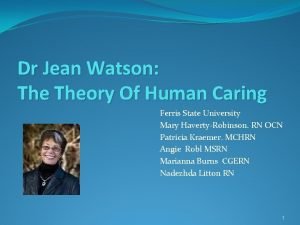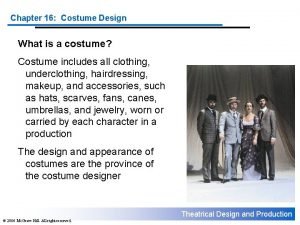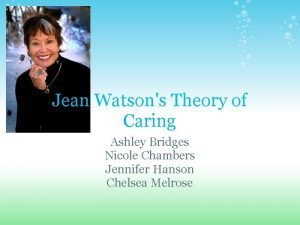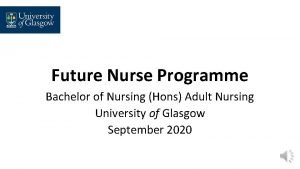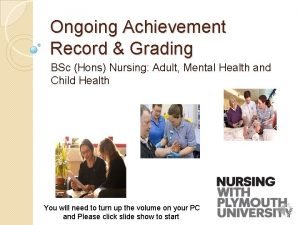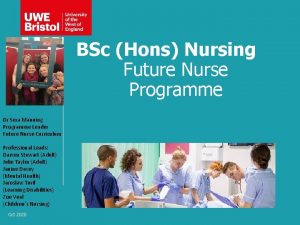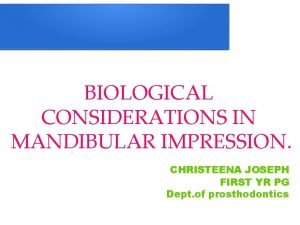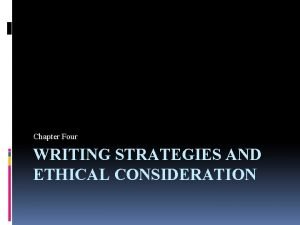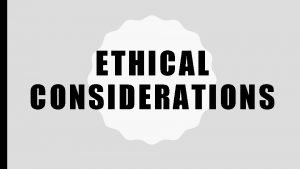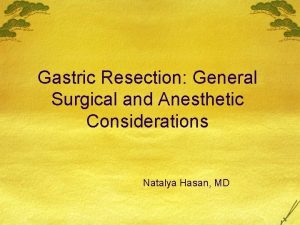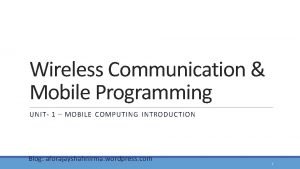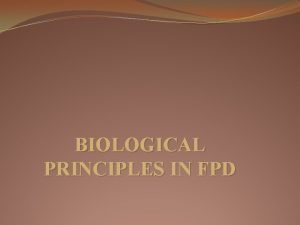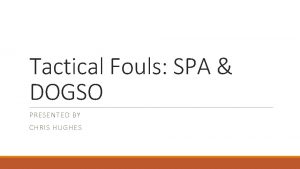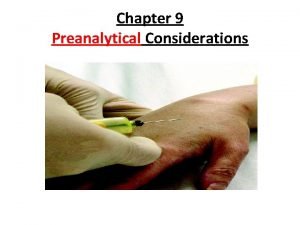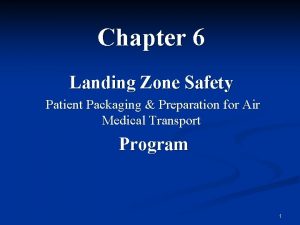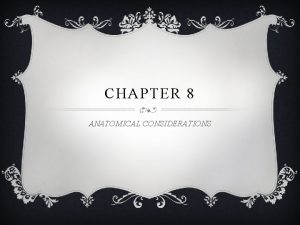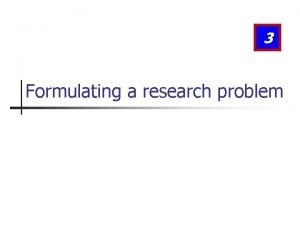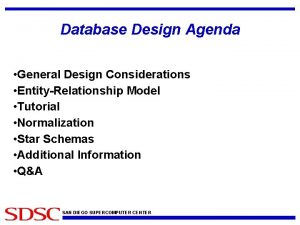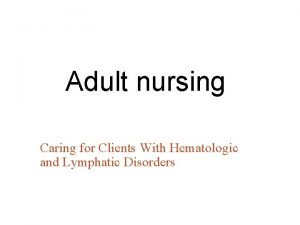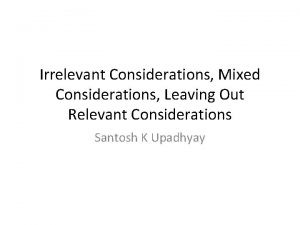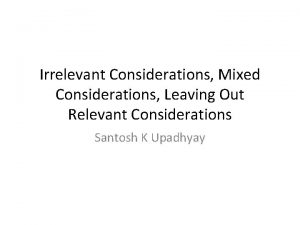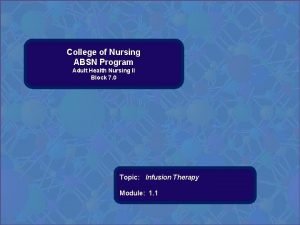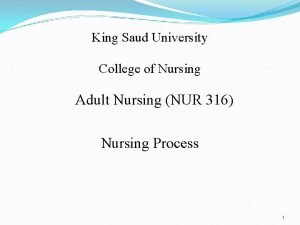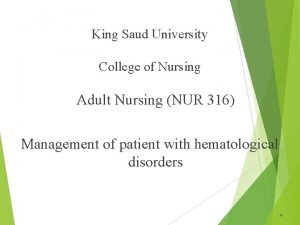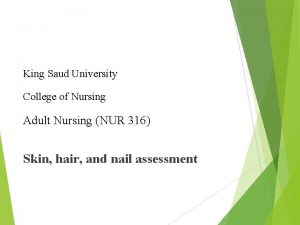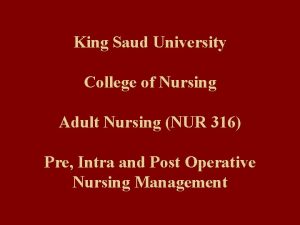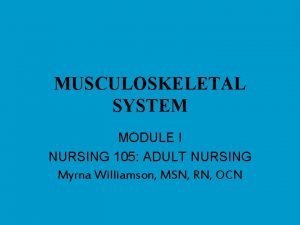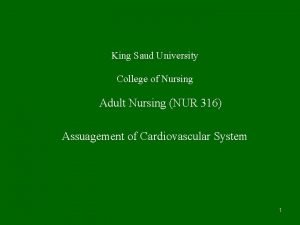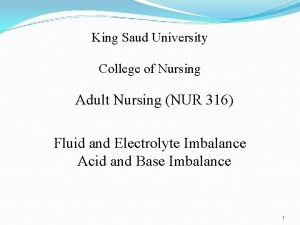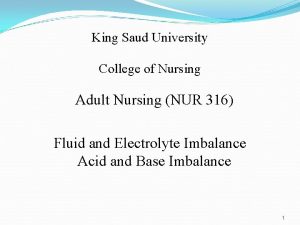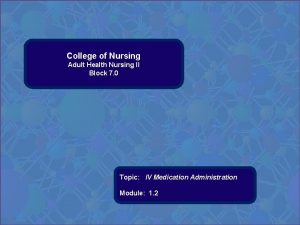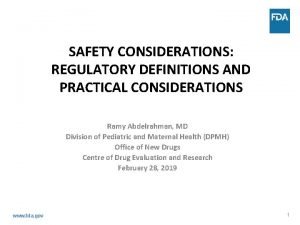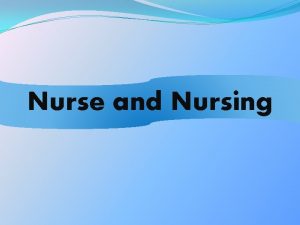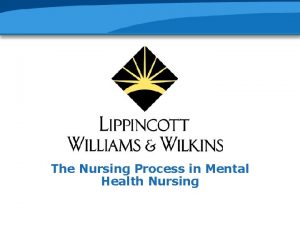Practical Nursing Considerations for Caring for the Adult


























- Slides: 26

Practical Nursing Considerations for Caring for the Adult Congenital Heart Patient Kristi Ryan, APN

Objectives • Understand practical nursing considerations for caring for the adult patient with congenital heart disease • Common congenital heart complications that bring patients to the hospital • What makes these patients different? . . . Beyond the anatomy and physiology

Normal Cardiac Anatomy

Cardiac Pressures

ACHD Defects • Classifications: Simple, Moderately complex, and Highly complex • ACHA (Adult Congenital Heart Association) ACHAHeart. org

Simple CHD Unrepaired: • Small ASD • Small VSD • Mild PS Repaired: • PDA • Isolated Ao. V • ASD • Isolated MV • VSD Repaired/Unrepai • PFO One visit to ACHD program then can be followed by general cardiologist or congenital cardiologist Any new issues should be re-evaluated by ACHD clinic ACHAHeart. org

Moderately complex CHD • • ALCAPA P/TAPVR AV Canal Sinus venosus ASD Coarctation Ebstein’s anomaly RVOTO • PV regurgitation(> mod) • PV stenosis (> mod) • Subvalvar or supravalvar AS • Tetralogy of Fallot • VSD with valve problem or obstructions Follow up every 2 years or more with ACHD program ACHAHeart. org

Highly Complex CHD • Eisenmenger syndrome • All cyanotic patients • L-TGA • DORV • Mitral atresia • Pulmonary atresia • Shone’s complex • Single ventricle • D-TGA • Tricuspid atresia • • • Truncus Heterotaxy s/p BT shunt s/p conduit s/p double switch Fontan Mustard/Senning Norwood Rastelli At least annual visit at ACHD program ACHAHeart. org

Common Adult Lesions CHD diagnosed in adulthood • Atrial Septal Defect (ASD) • Coarctation of Aorta • Congenitally Corrected Transposition (L-TGA) • Patent foramen ovale

Re-operation/Intervention • • • Aortic regurgitation • Aortic stenosis • Aortic root enlargement • Coarctation of aorta Pulmonary regurgitation/stenosis • RV to PA conduit failure Fontan revision Mustartd/Senning baffle obstruction Arrhythmia interventions: – ICD/pacemakers – Ablations – Cardioversions

Atrial Septal Defects (ASD)

ASD • ~1/3 diagnosed as an adult • Multiple types of ASDs: – PFO, secundum, primum, sinus venosus • Symptoms and presentation depends – Size of hole – Location – Any other defects, comorbidities – Age • Closure: cath lab vs. surgery • Eisenmenger Syndrome- long term complication if unrepaired

Eisenmenger Syndrome RN Tidbit: WATCH FOR AIR BUBBLES IN IV LINES!!!

Tetralogy of Fallot (TOF) Four abnormalities: • Ventricular septal defect (VSD) • RV outflow tract obstruction (Subpulmonary stenosis) • Right ventricular hypertrophy • Overriding aorta

TOF: Initial Palliation • Need to establish pulmonary blood flow • Classic BT Shunt ligated the subclavian artery RN Tidbit: NO BP IN ARM WITH A CLASSIC BT SHUNT!!!

TOF: Surgical Repair Valve Sparing Repair RV to PA Conduit

Adult RV to PA Replacement Transcatheter valve replacement – Melody Transcatheter Pulmonary Valve – Edwards Sapien XT Pulmonary Valve Surgical replacement – Redo sternotomy

Coarctation of Aorta • Diagnosed any time in life • 4 extremity BP helpful in diagnosis and monitoring • Commonly associated with bicuspid aortic valve Narrowing of aorta

Repair of coarctation Surgical Intervention Catheter intervention RN Tidbit: NO BP IN ARM WITH A SUBCLAVIAN FLAP REPAIR!

Where will you see them? • • • Emergency room Operating room and post op (CVICU) Cardiology and medical admissions Labor & delivery Psychology admissions

Reason for hospitalization Complex ACHD • CHF • Respiratory disorders • Arrhythmias Simple ACHD (ASD/PFO excluded) • Valve disease • Coronary artery disease • Arrhythmias Shikhar Agarwal et al. J Am Heart Assoc 2016; 5: e 002330 Simple ASD/PFO • CVA- 26% • Arrhythmia

Tips for admitting ACHD • Identify patient as ACHD patient – Were they born with the defect? – Do they have a scar in the middle of chest or a thoracotomy? – Did they see a cardiologist as a child? • Consult the ACHD team! • Only ~10% of ACHD patients in the US are currently getting the ACHD care that is recommended

Why are they different? • Increased incidence of comorbidities: obesity, hypertension, smoking, kidney disease • Psychological impact of- depression and anxiety more common • Social considerations • Quality of life

Summary • ACHD patients are special • There are some nursing considerations that must be considered- the key is ASSESSMENT and consultation! • Nearly all congenital heart patients need life long follow up with an ACHD specialist. Many have been lost to follow up. They may show up in your office, ED or department. • There are lots of resources available to you. Never hesitate to call our office.

“…I think those of us who have had life-threatening illness have been blessed with a knowledge of how precious life is. ” -Dylan Henricks “To be able to survive in spite of poor odds, there has to be a strong will and a passion for life. ” -Tara Shane “As a child, I was very ashamed of all my scars and never wanted anyone to see them. As I’ve gotten older, I’ve realized that without those scars I wouldn’t be alive today and able to do the great things I’ve done. ” -Kayla Pepmeyer

Kristi Ryan, APN Adult Congenital Heart Childrens Hospital of Illinois OSF St. Francis Kristi. n. ryan@osfhealthcare. org 309 -624 -3893 THANK YOU!!!
 Dr jean watson
Dr jean watson Types of costume design
Types of costume design Venturi mask flow rate
Venturi mask flow rate Caring is the essence of nursing jean watson
Caring is the essence of nursing jean watson Boykin and schoenhofer
Boykin and schoenhofer Bsc hons adult nursing
Bsc hons adult nursing Bsc hons adult nursing
Bsc hons adult nursing Bsc hons adult nursing
Bsc hons adult nursing Retro mylohyoid curtain
Retro mylohyoid curtain Writing strategies and ethical considerations
Writing strategies and ethical considerations What is moral consideration in ethics
What is moral consideration in ethics Natalya hasan
Natalya hasan Durite
Durite Design considerations for mobile computing
Design considerations for mobile computing Mechanical principles of tooth preparation
Mechanical principles of tooth preparation Eswl anesthesia considerations
Eswl anesthesia considerations Mechanical design of transmission line
Mechanical design of transmission line Web security considerations
Web security considerations Spa y dogso
Spa y dogso Preanalytical considerations phlebotomy
Preanalytical considerations phlebotomy Azure landing zone considerations
Azure landing zone considerations Ethical issues of experimental research
Ethical issues of experimental research Tax considerations for setting up a new business
Tax considerations for setting up a new business Appendices example in research paper
Appendices example in research paper Anatomical considerations
Anatomical considerations Formulating objectives examples
Formulating objectives examples Database design considerations
Database design considerations
